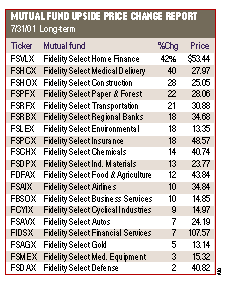TRADING SYSTEMS
Investing With Inertia
Trade Sector Funds With Pure Momentum
by Jay Kaeppel
Can you trade mutual funds once a month, never cut losses, and still make a lot of money?
In the July 1999 Technical Analysis of STOCKS & COMMODITIES, I wrote about one of the systems I use to trade Fidelity Select sector funds. That system was referred to as the relative strength system (or RS System for short). In this article, I will discuss another system that I use for trading sector funds. This one is referred to as the pure momentum system (or PM System). Like the RS System, the PM System holds a portfolio of up to five sector funds at any time. Because the PM System is similar to the RS System, the results tend to be highly correlated. In fact, there is usually some overlap between the funds held by both systems. Both systems make the bulk of their money by latching onto the strongest sectors and riding them, and so this high degree of correlation is not necessarily a bad thing. But it does mean that you must be willing to live with a certain amount of volatility.
If not for the favorable trading results, the pure momentum system could almost be considered more of a filtering tool than a full-blown system. In essence, the PM System is simply a stripped-down version of the RS System. Nevertheless, I have found enough of a difference between them that I trade them simultaneously as two independent systems. As with the RS System, I use AIQ TradingExpert to run the PM System, but you can get the same results using any other method that measures mutual fund performance over a selected time frame. It's really a simple process.
PURE MOMENTUM TRADING SYSTEM RULES
Mutual fund data is readily available after the close of each trading day.
1. After the close on the last trading day of each month, identify the
five sector funds (at the time of this writing, Fidelity was offering 40
Select sector funds) that have advanced the most in price over the past
240 trading days.
2. By the close of the next trading day, you should be holding the five
funds selected in the previous step.
3. Hold these funds until the end of the month.
4. Repeat the above three steps.
It sounds too easy, doesn't it? From an operational standpoint, it's simple, but as with any trading system, there are some important points and some areas of concern that need to be addressed.
SYSTEM STRONG POINTS
The advantages of this system are:
Historical results have handily beaten the major market averages. The system held up reasonably well in 1990, 1994, and 2000 - difficult years for the major averages. Ease of use. It takes no more than a few minutes a month to update the system and usually only a few minutes more to place any orders. The ratio of total return divided by time spent monitoring the system is probably the highest of any system I have personally developed. The system is designed to"go with strength," and does a very good job of riding the top-performing sectors. Turnover tends to be low, generally; there is not much turnover in the portfolio from month to month. Most months there is at least one change, sometimes two changes, and only very rarely three or more.

FIGURE 1: THE PURE MOMENTUM SYSTEM. Using a simple system, you can identify the sector funds that have advanced the most in price over the last 240 days. In this case, Aiq software was used.
...Continued in the November 2001 issue of Technical Analysis of STOCKS & COMMODITIES
Jay Kaeppel is the director of research at Essex Trading Co., Ltd. A registered CTA, he actively manages futures trading accounts through Essex Trading. He is also the codeveloper of Futures Pro and Option Pro software. He writes a weekly column updating the system detailed in this article, as well as other trading systems, on www.eCharts.com. He can be reached via e-mail at hftwp@aol.com.
Excerpted from an article originally published in the November 2001 issue of Technical Analysis of STOCKS & COMMODITIES magazine. All rights reserved. © Copyright 2001, Technical Analysis, Inc.